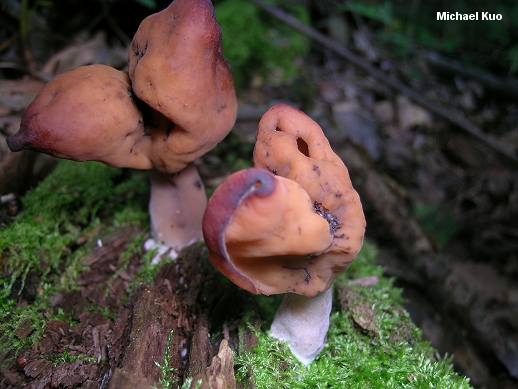Gyromitra infula
Bishop's miter ( Gyromitra infula )
The bishop's cap ( Gyromitra infula ) is a species of fungus in the family Lorchelverwandten. General characteristics are the limp hat, often curved upwards with wrinkles, and the appearance of late-autumn period of fruiting bodies.
- 6.1 Literature
- 6.2 Notes and references
- 6.3 External links
Features
Macroscopic characteristics
The hat of the bishop's cap is 3-8 cm wide and up to 10 cm high. The lobed shaped hat is often bent with two to four corners, up the hat surface may be wavy - wrinkled, veined or pitted. The total amount of the fungus is up to 20, exceptionally, 30 cm. The coloring of the fruit -bearing layer is Hutaußenseite meat, cinnamon or chestnut brown. The inside of the hollow hat is white.
The cylindrical, straight or slightly curved stalk may be 4 to 10 cm high and 1.5 to 3 cm thick. He is grauweißlich to flesh-colored and frosted on the surface to feinfilzig. In particular, towards the base of the stem is often wrinkled or pitted. The Hutlappen are united at the border with the stem. The stem is in young fruiting bodies filled with a pithy cell mass and later hollow inside.
The flesh is waxy, fragile and has an uneventful until pleasant smell and taste.
Microscopic characteristics
The fruit layer ( hymenium ) is located on the surface of the hat. The spores are elliptical and measure 20-23 × 8.5-9.5 microns. They are hyaline and have at each end a drop of oil. Its surface is smooth. The asci are 200-350 microns long and 12-17 microns wide. There are eight spores in them. The paraphyses are club-shaped, often forked at the top and at the ends have a diameter of 7-10 microns.
Artabgrenzung
The fruktifizierende in the spring morel has no limp - zipfeligen, but a brain -wound hat. The Hutstruktur the miter resembles some Helvella species; However, these tend to have more gray colors and furrowed stems. Bendix described in 1966 which differs from a " normal form " of the bishop's miter " burns variant" Gyromitra infula var gyrósa with more brain -like spiral hat shape. The occurring in northern Europe between the 57th and 70th parallels of latitude Multifarious Lorchel ( Gyromitra ambigua ) has a more purple toned hat and stem as well as longer and more spindle- shaped spores. It occurs under pines and is toxic.
Ecology and phenology
The bishop's cap grows as Saprobiont in coniferous forests with spruce and pine, especially in montane layers over limestone and silicate rock. The fruiting bodies appear on timber yards intermediate strains, also they also occur on stumps and fire places. The mostly single growing fruit bodies are formed in the autumn from September to November.
Dissemination
The type of fungus is widespread in Europe, Asia and North and South America. In the Alps it occurs relatively frequently in the low mountain ranges in Germany, in southern Poland and northern Europe only scattered before. You lack in the northern German lowlands as well as in Denmark.
Importance
The feed value of the miter is controversial. According to Gerhardt, the fungus is usually considered edible. Centrifugal described him as very tasty. However, some authors report a Gyromitringehalt as the morel, but in much smaller amounts, or of poisoning similar to Gyromitra syndrome. Laux already looks the way because of their rarity rather than edible mushroom.









.jpg)
